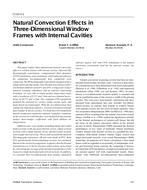This paper studies three-dimensional natural convection effects in window frames with internal cavities. Infrared (IR) thermography experiments, computational fluid dynamics (CFD) simulations, and calculations with traditional software for simulating two-dimensional heat conduction were conducted. The IR thermography experiments mapped surface temperatures during steady-state thermal tests between ambient thermal chambers set at 0ºC and 20ºC. Using a non-contact infrared scanning radiometer and an external referencing technique, we were able to obtain surface temperature maps with a resolution of 0.1ºC and 3 mm and an estimated uncertainty of ±0.5ºC and ±3 mm. The conjugate CFD simulations modeled the enclosed air cavities, frame section walls, and foam board surround panel. With the two-dimensional heat conduction simulation software, we used correlations to model heat transfer in the air cavities. For both the CFD simulations and the conduction simulation software, boundary conditions at the external air/solid interface were modeled using constant surface heat-transfer coefficients with fixed ambient air temperatures. Different cases were studied, including simple, four-sided frame sections (with one open internal cavity), simple vertical sections with a single internal cavity, and horizontal sections with a single internal cavity. The sections tested in the Infrared Thermography Laboratory (IR lab) were made of PVC. Both PVC and thermally broken aluminum sections were modeled. Based on the current investigations, it appears that the thermal transmittance or U-factor of a four-sided section can be found by calculating the average of the thermal transmittance of the respective single horizontal and vertical sections. In addition, we conclude that two-dimensional heat transfer simulation convection correlations used for the internal cavities are correct.
Units: SI
Citation: Symposium, ASHRAE Transactions, vol. 107, pt. 2
Product Details
- Published:
- 2001
- Number of Pages:
- 11
- File Size:
- 1 file , 730 KB
- Product Code(s):
- D-7057
